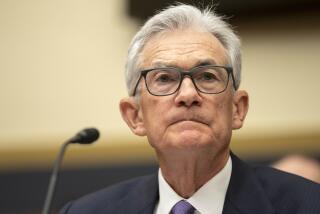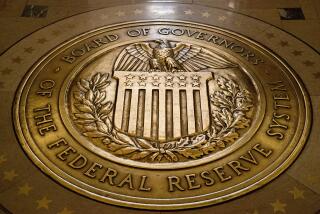Fed sticks to status quo on interest rates, bond-buying plan
Federal Reserve policymakers Wednesday kept interest rates at near zero and pledged to charge ahead with their controversial bond purchases to stimulate the economy. The move came despite signs of a strengthening economy and some new voting members at the Fed who have raised concerns about the Treasury bond-buying program.
Fed officials, in their first monetary policy-setting meeting of the year, acknowledged the latest pickup in the recovery. They noted the rise in business investments for equipment and software, and in particular the stronger consumer spending late last year that resulted in the best holiday retail sales season since 2006.
But overall, the tone of the central bank’s outlook was cautious. Investment in commercial real estate is still weak, the Fed said, the housing market continues to be depressed, and “employers remain reluctant to add to payrolls.”
Although the U.S. economy has been growing since summer of 2009, the nation’s unemployment rate has been above 9% since May 2009.
As expected, policymakers stuck with their policy — now more than 2 years old — of holding short-term interest rates at rock bottom. They reiterated that’s where it would stay for “an extended period.”
Most analysts don’t expect a Fed rate hike until next year. “That’s still way off into the future,” said Josh Feinman, global chief economist for DB Advisors, an asset management unit of Deutsche Bank. “Fact is, unemployment is too high and inflation too low.”
Also, the Fed reaffirmed its commitment to buy $600 billion of long-term Treasury securities by the end of June. The program was launched in November and is aimed at pushing down long-term interest rates by pumping more money into the financial system to spur borrowing and spending. But it has been criticized as lacking potency and creating risks of higher inflation down the road.
The Fed’s statement Wednesday gave a nod to the recent rise in prices of commodities including oil, grains and rubber — an increase that has stoked inflationary pressures in emerging economies and prompted warnings from the European central bank’s president, Jean-Claude Trichet, of an inflation threat to the global economy.
Even so, Chairman Ben S. Bernanke and his colleagues at the Fed indicated they weren’t worried about that at the moment. Fed officials tend to put more stock in core inflation, which excludes volatile food and energy prices. That rate has been running at less than 1%, about half of the Fed’s informal target.
Bernard Baumohl, chief global economist at the Economic Outlook Group, generally agreed with the Fed’s assessment of economic conditions, saying he wasn’t worried that increased commodity prices would translate into higher prices for American consumers. In the current economic climate, he said, businesses “don’t have much pricing power. If they transferred prices, they would lose customers.”
At the same time, Baumohl said he and some bond investors were becoming concerned about the Fed’s commitment to its bond-buying program, as it would inject billions into the financial system even though economic growth looks to be accelerating. “The moment [bond investors] believe inflation expectation is picking up … we could see a stampede out of the bond market,” he said.
So far, inflation expectations have held fairly steady, as reflected in surveys and spreads between certain Treasury bills. But that could change as the year progresses.
The Fed’s policy-setting group began the year with four new voting members, three of whom are considered to be more “hawkish” in their attitude toward inflation. The change in makeup of the current 11 voting members of the committee had raised speculation of increasing dissent as the central bank delicately balances the need to boost employment while remaining a bulwark against inflation.
However, Wednesday’s policy statement was approved unanimously.







